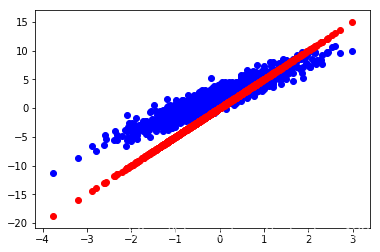import tensorflow as tf
tf.enable_eager_execution()
Variable operator
x = tf.zeros([10, 10])
x += 2 # This is equivalent to x = x + 2, which does not mutate the original
# value of x
print(x)
tf.Tensor(
[[2. 2. 2. 2. 2. 2. 2. 2. 2. 2.]
[2. 2. 2. 2. 2. 2. 2. 2. 2. 2.]
[2. 2. 2. 2. 2. 2. 2. 2. 2. 2.]
[2. 2. 2. 2. 2. 2. 2. 2. 2. 2.]
[2. 2. 2. 2. 2. 2. 2. 2. 2. 2.]
[2. 2. 2. 2. 2. 2. 2. 2. 2. 2.]
[2. 2. 2. 2. 2. 2. 2. 2. 2. 2.]
[2. 2. 2. 2. 2. 2. 2. 2. 2. 2.]
[2. 2. 2. 2. 2. 2. 2. 2. 2. 2.]
[2. 2. 2. 2. 2. 2. 2. 2. 2. 2.]], shape=(10, 10), dtype=float32)
v = tf.Variable(1.0)
assert v.numpy() == 1.0
# Re-assign the value
v.assign(3.0)
assert v.numpy() == 3.0
# Use `v` in a TensorFlow operation like tf.square() and reassign
v.assign(tf.square(v))
assert v.numpy() == 9.0
v = tf.Variable(1.0)
assert v.numpy() == 1.0
# Re-assign the value
v.assign_sub(0.5)
'''
assign_sub
相当于-=
'''
print(v.numpy())
v=tf.Variable([-1,-1,-1])
tf.scatter_update(v,tf.constant([2,1,0]),tf.constant([4,5,6]))
'''
tf.scatter_update(
ref,
indices,
updates,
use_locking=True,
name=None
)
'''
print(v.numpy())
0.5
[6 5 4]
tensor and Variable
ret=tf.constant([2,1,0])
print(ret.numpy())
[2 1 0]
ret=tf.Variable([2,1,0])
print(ret.numpy())
[2 1 0]
Variable和Variable/Constant/Tensor运算后成为Tensor类型
ret=tf.Variable([2,1,0])
print(ret.numpy())
ret2=ret*3
print(type(ret2))
ret2=tf.Variable(ret2)
print(type(ret2))
[2 1 0]
<class 'tensorflow.python.framework.ops.EagerTensor'>
<class 'tensorflow.python.ops.resource_variable_ops.ResourceVariable'>
ret=tf.Variable([2,1,0])
print(ret.numpy())
ret2=ret*tf.Variable(3)
print(type(ret2))
ret2=tf.Variable(ret2)
print(type(ret2))
[2 1 0]
<class 'tensorflow.python.framework.ops.EagerTensor'>
<class 'tensorflow.python.ops.resource_variable_ops.ResourceVariable'>
ret=tf.Variable([2,1,0])
print(ret.numpy())
ret2=ret*tf.constant(3)
print(type(ret2))
ret2=tf.Variable(ret2)
print(type(ret2))
[2 1 0]
<class 'tensorflow.python.framework.ops.EagerTensor'>
<class 'tensorflow.python.ops.resource_variable_ops.ResourceVariable'>
ret=tf.Variable([2,1,0])
print(ret.numpy())
ret2=tf.multiply(ret2,3)
print(type(ret2))
ret2=tf.Variable(ret2)
print(type(ret2))
[2 1 0]
<class 'tensorflow.python.framework.ops.EagerTensor'>
<class 'tensorflow.python.ops.resource_variable_ops.ResourceVariable'>
ret=tf.Variable([2,1,0])
print(ret.numpy())
ret2=tf.add(ret2,3)
print(type(ret2))
ret2=tf.Variable(ret2)
print(type(ret2))
[2 1 0]
<class 'tensorflow.python.framework.ops.EagerTensor'>
<class 'tensorflow.python.ops.resource_variable_ops.ResourceVariable'>
class Model(object):
def __init__(self):
# Initialize variable to (5.0, 0.0)
# In practice, these should be initialized to random values.
self.W = tf.Variable(5.0)
self.b = tf.Variable(0.0)
def __call__(self, x):
return self.W * x + self.b
model = Model()
assert model(3.0).numpy() == 15.0
def loss(predicted_y, desired_y):
return tf.reduce_mean(tf.square(predicted_y - desired_y))
TRUE_W = 3.0
TRUE_b = 2.0
NUM_EXAMPLES = 1000
inputs = tf.random_normal(shape=[NUM_EXAMPLES])
noise = tf.random_normal(shape=[NUM_EXAMPLES])
outputs = inputs * TRUE_W + TRUE_b + noise
import matplotlib.pyplot as plt
plt.scatter(inputs, outputs, c='b')
plt.scatter(inputs, model(inputs), c='r')
plt.show()
print('Current loss: '),
print(loss(model(inputs), outputs).numpy())

Current loss:
9.460205
def train(model, inputs, outputs, learning_rate):
with tf.GradientTape() as t:
current_loss = loss(model(inputs), outputs)
dW, db = t.gradient(current_loss, [model.W, model.b])
model.W.assign_sub(learning_rate * dW)
model.b.assign_sub(learning_rate * db)
model = Model()
Ws, bs = [], []
epochs = range(10)
for epoch in epochs:
Ws.append(model.W.numpy())
bs.append(model.b.numpy())
current_loss = loss(model(inputs), outputs)
train(model, inputs, outputs, learning_rate=0.1)
print('Epoch %2d: W=%1.2f b=%1.2f, loss=%2.5f' %
(epoch, Ws[-1], bs[-1], current_loss))
# Let's plot it all
plt.plot(epochs, Ws, 'r',
epochs, bs, 'b')
plt.plot([TRUE_W] * len(epochs), 'r--',
[TRUE_b] * len(epochs), 'b--')
plt.legend(['W', 'b', 'true W', 'true_b'])
plt.show()
Epoch 0: W=3.19 b=1.80, loss=1.14858
Epoch 1: W=3.15 b=1.84, loss=1.11297
Epoch 2: W=3.11 b=1.88, loss=1.09001
Epoch 3: W=3.08 b=1.90, loss=1.07521
Epoch 4: W=3.06 b=1.93, loss=1.06567
Epoch 5: W=3.04 b=1.94, loss=1.05952
Epoch 6: W=3.02 b=1.96, loss=1.05555
Epoch 7: W=3.01 b=1.97, loss=1.05300
Epoch 8: W=3.00 b=1.98, loss=1.05135
Epoch 9: W=2.99 b=1.98, loss=1.05028
